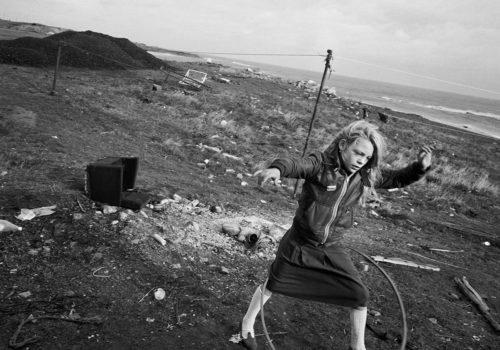The material for Chris Killip’s first published photobook dates to 1970-73 after he returned to the Isle of Man where he had grown up. He had been enrolled there in a hotel management course when he had come across a photograph that changed his life. Seeing Cartier-Bresson’s Boy with two bottles of wine, Rue Mouffetard was a road to Damascus moment: abandoning the hotel course, he took a job taking photos of holidaymakers before moving to London in 1964 and finding employment as an assistant with the photographer Adrian Flowers.
The sixties were swinging in London but Killip was responsive to a gentler rhythm when he returned home and began photographing a lifestyle that he had been familiar with since childhood. His photos on the Isle of Man show a family resemblance to Tom Wood’s Irish Work, grounded in the two photographers’ acquaintance with farming life and the way it shaped the character in those engaged in it. The two photographers show awareness of an agricultural way of life drawing to a close – financial services were starting to sense rich pickings in the Isle of Man as an emerging tax haven – and a consequent need to record an integrity and wholeness that informed not only farming’s working practices but the bodies of those who constituted that way of existing in the world.
After the Isle of Man, Killip travelled around the north of England before finding a new home in Tyneside. Between 1982 and ’84 he photographed a village forty miles to the south, a place which, as Ken Grant observes in one of his richly informative contributions to Thames & Hudson’s new monograph, Chris Killip, owed not a little of its existence to migrant workers from Ireland. Killip’s sense of some partly originary Irish presence in the village of Skinningrove, as with the peasant culture discernible on the Isle of Man, helped draw him closer to communities that lived on the margin, those who, in Killip’s words, ‘have history done to them, who have felt its malicious disregard’. Countering the passivity that this might imply, his photos of bodies as expressions of a social condition have a positivity that opposes any denigration of the unprivileged. His achievement, as becomes clear in his affecting video of time spent in Skinningrove, was the result of building the trust of those wary of a stranger arriving in their village wielding a large-format camera. Distrust became outright hostility when he set out to take pictures at another place, a beach at Lynemouth some twenty miles north of Newcastle. It was a spot where people came to gather coal that collected there from the spoil of mined seams under the North Sea and the story of Killip’s eventual acceptance on the beach is nicely told by Ken Grant.
The sections of Chris Killip devoted to his output in Tyneside, Skinningrove and Lynemouth are the book’s centre of gravity. At one level, the photographs are visual testimony to what Jacques Rancière called the ‘part of no part’, those not given a voice within the larger social order that exercises governance over them, but the philosopher also coined the term ‘a community of equals’ and this is more fitting as a description of what Killip made visible by investing his subject matter with a presence that amounts to a counting of the uncounted. In the photo ‘Crabs, people, dogs 1981’, a composition on the shoreline in Skinningrove, the camera is behind a man and woman looking out to sea, an unseen baby in a pram, a driver at the wheel of a parked car, a cart of crabs and two dogs alertly glancing in different directions. An undefined apprehension may be thought to accompany the process of waiting that inhabits the scene but while there is a degree of anticipation or even mystery to the mise en scène it amounts to inconclusiveness, not angst. The adults may seem disconnected from one another but the two standing dogs act as a frame for a coming together that is not discordant and the wheels of the cart and pram (and the car) help lend some unity to the tableau.
Killip also took a photograph of the setting behind them – the picture appears in the video mentioned above – providing a very ordinary picture of Skinningrove by the shore. It is not one of his better photos but its gathering of cars, dogs, people, and this time the baby in the pram is visible, is a snapshot of quotidian life in a place where people have something in common with one another. There is no pact between them but there is companionship and a shared existence, the virtue of which is perhaps best summed up in Killip’s shot of a family out for a Sunday walk on high ground above the village. As in ‘Crabs, People, Dogs’, the man’s posture might suggest a longing for something and the woman complements this sense of a desideratum but instead of resignation there is resolve and, along with the sense of a lack of completion, it fills the silence that is around them. Skinningrove is no Eden and the family possess the same firmness that accompanied the first human couple stepping out as described by Milton in the final lines of Paradise Lost.
It is the refusal of the tragic that underscores Chris Killip’s greatness and he should not be boxed in as a documentrian of de-industrialisation. He photographed resistance and rebellion, from striking workers to punks at play, as a way of hailing the importance of insubordination and it is right and fitting that the concluding essay in this book, by Lynsey Hanley, draws attention to the political education that Killip’s work provides. His achievement is celebrated with the depth it deserves in Thames & Hudson’s book and in the related Chris Killip, Retrospective which is at The Photographers Gallery, London until 19 February 2023.
Sean Sheehan
Chris Killip
Ken Grant, Tracy Marshall-Grant
Thames & Hudson
https://www.thamesandhudsonusa.com/books/chris-killip-hardcover
















